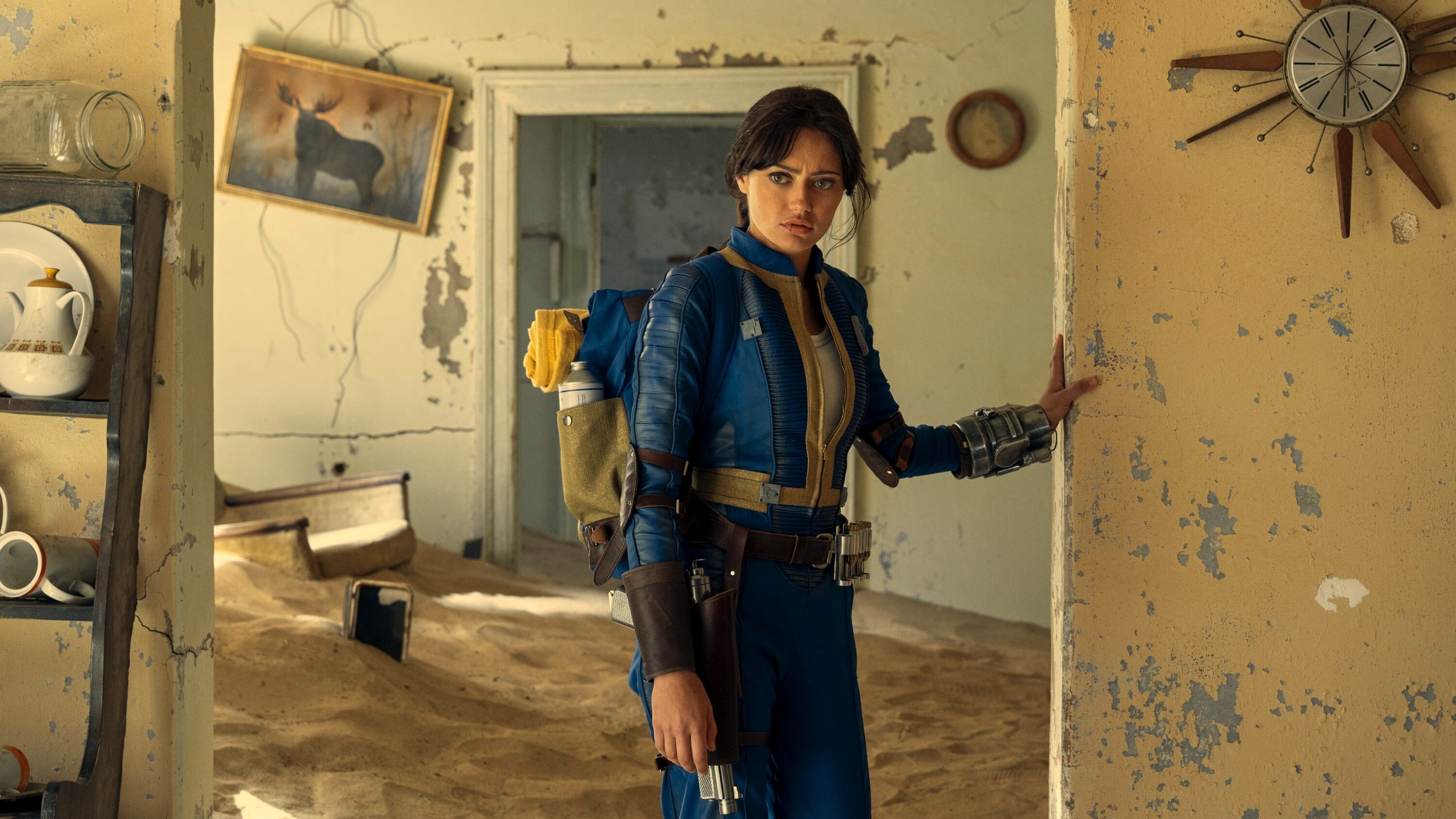
This article contains spoilers for Amazon’s Fallout TV series and the Fallout games.
Amazon’s long-awaited adaption of the Fallout franchise is a smashing success that has reignited interest in the Fallout games. In general, it seems to be a great time to be a Fallout fan.
Yet, look at certain corners of the internet (you know the ones), and you’ll likely find quite a bit of discourse over the state of the Fallout timeline. Long story short, it seems that some Fallout fans feel that the TV show deliberately altered the Fallout franchise timeline in ways that they consider to be an insult to the series and some of those who contributed to its growth.
While it’s relatively easy to dismiss those claims and filter them out with the rest of the internet toxicity we endure in a given day, there is a little more smoke around this mushroom cloud than there may initially appear to be. That being the case here’s what you need to know about the Fallout timeline situation.
What Is The Official Fallout Timeline?
As Amazon’s Fallout series is a canonical entry in the franchise, Fallout developer Bethesda Game Studios recently updated the official Fallout timeline to help show where, exactly, that series fits in. Here’s a rough overview of that timeline so far:
The First Nuclear Bombs Are Launched – 2077
Fallout 76 – 2102
Fallout 1 – 2161
Fallout Tactics – 2197
Fallout 2 – 2241
Fallout 3 – 2277
Fallout: New Vegas – 2281
Fallout 4 – 2287
Fallout TV Series – 2296
Nothing about that timeline should immediately raise any red flags. We’ve long known that Fallout 76 takes place before any of the other games, we already knew that 2004’s Brotherhood of Steel game isn’t currently considered canonical, and the TV series’ place at the end of the timeline seemingly gives it a healthy amount of breathing room from the rest of the franchise.
Furthermore, the events of the Fallout games have always been loosely connected. Certain historical events, characters, and concepts are present throughout each of the games, but many of those games tell largely isolated stories that happen to be set in the same universe. It’s part of the reason the TV series works as well as it does. It is ultimately just another in a long line of Fallout stories.
So why is that series causing so much chronological confusion? Well, I’m glad you asked….
The Shady Sands and New Vegas Problem, Explained
Throughout Amazon’s Fallout series, several references are made to a city called Shady Sands. In the Fallout games, Shady Sands was considered to be the first capital (relatively speaking) of the New California Republic and one of the most significant cities in the “post-nuclear” United States.
Well, the Fallout TV series tells us two new things about Shady Sands. The first is that series co-protagonist Maximus was raised there. The second is that Shady Sands was actually destroyed sometime before the events of the show. The reveal that Shady Sands was destroyed was certainly a shocking moment for fans of the Fallout games but taken on its own, that event doesn’t necessarily contradict what we knew (or suspected) about Shady Sands from those games.
The problem comes in the sixth episode of Amazon’s Fallout series (“The Trap”) when we see a blackboard drawing that claims “The Fall of Shady Sands” took place in 2277. Notably, that event is connected to the rest of the Shady Sands timeline with an arrow that leads us to (and ends on) a drawing of a mushroom cloud. We later learn that it was Hank MacLean (Lucy’s father) who orchestrated the bombing of Shady Sands. Keep those points in mind for later.
Looking at the timeline above, that means that the fall of Shady Sands took place around the time of the events of Fallout 3 (which was set in the Capital Wasteland region on the other side of the country) and before the events of Fallout: New Vegas (which is set in the Mojave Wasteland near Shady Sands itself).
The problem is that Shady Sands is referenced several times throughout Fallout: New Vegas and its DLC. Those references suggest that the city is not only very much intact but is still a major hub for various West Coast factions.
So why does the Fallout TV series tell us that Shady Sands was destroyed in 2277 if Fallout: New Vegas suggests it is still a relatively thriving city (if a source of constant conflict) in 2281?
Bethesda’s Explanation For the Fallout Timeline Inconsistencies
According to Bethesda Executive Producer Todd Howard, the Fallout showrunners asked for permission to destroy Shady Sands when scripting the TV series. In an interview with IGN, Howard says that he was shocked by the request and its possible implications but permitted them to follow through with the proposed event. He even says that Bethesda worked with them to ensure it occurred in a lore-friendly way.
So why the apparent timeline inconsistency? Well, according to Howard, there isn’t actually an inconsistency but rather an airtight window of time that keeps the timeline technically intact.
“We’re careful about the timeline,” Howard says. “There might be a little bit of confusion in some places. But everything that happened in the previous games, including New Vegas, happened…All I can say is we’re threading it tighter there, but the bombs fall just after the events of New Vegas.”
What Howard seems to be hinting at is one of two theories that many fans have already pointed out. The most likely of those theories is that “The Fall of Shady Sands” doesn’t refer to the bombing of Shady Sands and is instead a reference to a major turning point for the city. That would also explain why there is a small gap between the reference to the fall of the city and the drawing of the mushroom cloud.
The other notable possibility is that there was simply some kind of miscommunication/misinformation being tossed around the world in regards to when, exactly, certain things occurred. We are talking about the end of the world after all. It’s certainly not inconceivable that someone, somewhere got a date wrong.
As for why Howard doesn’t expand upon that answer, it’s likely because the Fallout TV series ends with a tease of New Vegas itself. If the fate of Shady Sands (and the events of the New Vegas game) will play a bigger role in Fallout‘s second season, then everyone involved probably wants to keep all of that under wraps for the time being.
Personally, I think that the blackboard drawing itself is the crux of this entire problem. There’s always a possibility that someone simply got some dates mixed up, but I’d sooner attribute this to some questionable design decisions.
Given that we knew Shady Sands was eventually bombed, referring to whatever happened in 2277 as the “Fall of Shady Sands” probably wasn’t a great decision if that event doesn’t refer to the destruction of the town. Some slightly different wording, a buffer event or two, or perhaps even a longer timeline arrow may have helped convey the difference between the “Fall” and the bombing itself a bit more clearly. Again, though, that’s all assuming this wasn’t just a simple case of human error.
However, there are bigger reasons why Fallout fans seem so hesitant to trust Bethesda and the Fallout showrunners regarding this matter.
Why Some Fans Are So Angry About the Fallout Timeline
While it’s unlikely that anyone reading this article is shocked by the idea of franchise fans using the internet to register their disgust over a possible lore/timeline era, there are other reasons why this particular event seems to be generating so much online outrage.
See, it’s not just that there was a possible lore inconsistency in the Fallout show; it’s that there was a possible lore inconsistency involving Fallout: New Vegas.
Since its release in 210, New Vegas has become a bit of a sticking point for some Fallout fans. It’s considered by many (myself included) to be the best Fallout game ever made, which is especially notable given that it’s the only major Fallout game of the last 16 years that wasn’t developed by Bethesda.
New Vegas was instead developed by Obsidian Entertainment, who used their extensive history with role-playing games to add some of the RPG elements to New Vegas that many fans felt were missing from Bethesda’s Fallout 3. For that matter, it’s worth noting that there were quite a few Fallout fans who were always disappointed by Fallout 3 and insisted that Bethesda was trying to turn the franchise into yet another Bethesda game rather than honor the core tenants of that series.
For some of those fans, New Vegas (despite being built with the Fallout 3 engine during a notoriously rushed production schedule) came much closer to feeling like a “true” Fallout game. That makes sense given that many of the people at Obsidian at that time previously worked at Black Isle Studios: the company that created the Fallout franchise and developed the original Fallout games.
Yet, Bethesda’s Fallout 4 failed to expand upon many of those qualities that made Fallout: New Vegas so noteworthy. If anything, it sometimes seemed to intentionally stray from the deeper RPG elements of New Vegas in order to incorporate mechanics seemingly designed to increase the Fallout franchise’s accessibility and reach. Given that Fallout 4 is by far the best-selling game in the Fallout franchise (and a major reason why we eventually got a Fallout TV show), those decisions seemed to pay off.
Despite all of that, there are many fans who would still prefer to see Obsidian take the reigns of the Fallout franchise (or at least be given the proper resources to develop a New Vegas sequel). Obsidian has even stated that they would love to make another Fallout game if given the chance to do so. While Obsidian studio head Feargus Urquhart remains hopeful they will one day get that chance, there have been no indications that there are any plans in place for Obsidian to work on another Fallout title. At the very least, Fallout 5 will almost certainly be a Bethesda game.
Between those who are still upset over Bethesda’s transformation of the Fallout franchise and those who believe the studio is actively preventing Obsidian from making another Fallout game, you have quite a lot of paranoid fans who are ready to believe that the Fallout show would deliberately sabotage elements of New Vegas‘ lore in an attempt to disown Obsidian’s contributions to the franchise. While there are some questions about the Shady Shore timeline that remain unanswered, this certainly doesn’t seem like a case of ill intentions. Indeed, some of the New Vegas team’s most prominent members have expressed their admiration of the Fallout TV series.
It’s unlikely this debate and the mistrust that fuels it is going anywhere, though. Between this whole Shady Shore thing, the Fallout series’ decision to add (possibly alter) a significant piece of lore to the franchise, and some concerns regarding Fallout 5‘s future in the wake of the disappointing debut of Bethesda’s Starfield, the Fallout fandom remains divided over the current era of the series.
That isn’t to say that there haven’t been (and will not continue to be) valid criticisms of the Fallout franchise in the Bethesda era. I’ve shared a few of them myself, and there will almost certainly be more to discuss in the future. However, when it comes to anything Fallout-related, just know that there are some out there who are always ready to go nuclear.
The post Why Everyone Is Freaking Out About the Fallout Timeline appeared first on Den of Geek.






